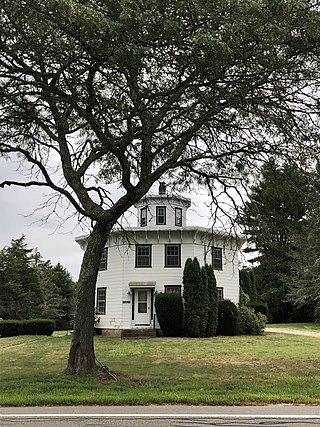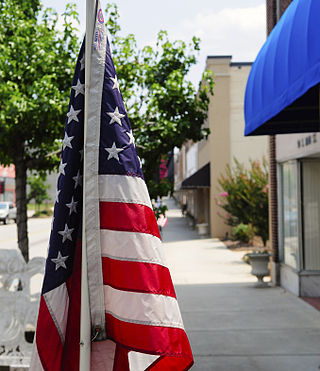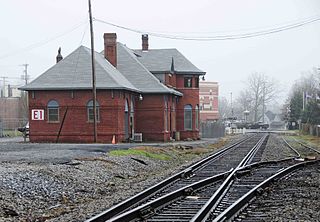
The city of Lancaster is the county seat of Lancaster County, South Carolina, United States, located in the Charlotte Metropolitan Area. As of the United States Census of 2010, the city population was 8,526. The city was named after the famous House of Lancaster.

Carolina is a village that straddles the border of the towns of Charlestown and Richmond on the Pawcatuck River in Washington County, Rhode Island. Rhode Island Route 112 passes through the village. Carolina is identified as a census-designated place, with a population of 970 at the 2010 census.

The Nashua Manufacturing Company Historic District in Nashua, New Hampshire, is a historic district that was listed on the National Register of Historic Places (NRHP) in 1987. It encompasses an area just west of downtown Nashua, roughly located along the southern bank of the Nashua River, bordered on the west side by Mine Falls Park, on the south side by the Nashua River canal, up to Ledge Street, and from the east side by Factory, Pine and Water streets, up to the Main Street bridge.

Mooresville Historic District is a national historic district located in Mooresville, Iredell County, North Carolina. It encompasses 62 contributing buildings and 8 contributing sites in the central business district and surrounding residential sections of Mooresville. The district includes notable examples of Italianate, Romanesque Revival, and Renaissance Revival architecture. Notable buildings include the Mooresville depot, the former Lorene Cotton Seed Oil Mill, First Presbyterian Church (1899), McLelland House, D. E. Turner Hardware Co. store, the former U. S. Post Office, and the McKnight Pontiac-Buick Co..

Woodside Cotton Mill Village Historic District is a national historic district located in Greenville County, South Carolina. The district encompasses 278 contributing buildings and 2 contributing sites in an early 20th century urban South Carolina textile mill village. Centered on a mill founded by John T. Woodside in 1902, the district is located just west of the city limits of Greenville and is largely intact despite modernizations made by a succession of mill and home owners. The mill itself is a rectangular, brick, four-story building designed by J.E. Sirrine and built between 1902 and 1912. Eventually the mill became the largest cotton mill under one roof in the United States and one of the largest in the world.

Lancaster Downtown Historic District is a national historic district located at Lancaster, Lancaster County, South Carolina. It encompasses 12 contributing commercial buildings in central business district of Lancaster. The buildings date from about 1880 to 1935. It is the most intact section of Lancaster's early business area. Notable building include the United States Post Office, the Springs Block, the Farmers’ Bank and Trust Company Building, and the Bank of Lancaster/Opera House.
Southern Cotton Oil Company, also known as Columbia Mill, was a historic cottonseed oil complex located at Columbia, South Carolina. The complex was built between 1887 and 1919. It consisted of seven industrial buildings: the Seed House, Linter Room, Press Room, Machine Shop, Oil House, Cotton Storage Room, and Storage Shed. Five of the buildings were constructed of brick and the other two were constructed of galvanized sheet metal. The complex has been demolished.

Buffalo Mill Historic District is a national historic district located at Buffalo, Union County, South Carolina. The district encompasses 190 contributing buildings and 2 contributing structures associated with the Buffalo Mill textile mill complex and mill village. The mill complex includes the main mill, mill office, power house, ice factory, mill warehouse, company store, and company bank/drug store. The main mill building features applied stylized Romanesque Revival detailing. The mill village housing varies from large, free-classic, Queen Anne style supervisor's houses, to shingle-style bungalows, to simple, one-story, workers residences. The village also includes a school and a baseball field/park.

Union Downtown Historic District is a national historic district located at Union, Union County, South Carolina. The district encompasses 48 contributing buildings in the central business district of Union. The commercial, public, residential, industrial, and transportation-related buildings were built between about 1878 to about 1940, with the majority dating from about 1880 to about 1930. The district includes buildings representative of the Neo-Classical and Victorian styles. Notable buildings include the Union County Courthouse, Union Post Office/Federal Building, Flynn Building, Krass Building, People's State Bank/Arthur State Bank, Union Depot, Union Cotton Oil Mill, and Union Hardware Co. Located in the district is the separately listed Fair Forest Hotel.

Highland Park Manufacturing Plant and Cotton Oil Complex is a historic industrial complex and national historic district located at Rock Hill, South Carolina. It encompasses three contributing building and two contributing structures in Rock Hill. The complex includes the Highland Park Manufacturing Plant, the Highland Park Cotton Oil Mill (1902), and the Highland Park Cotton Oil Mill Office (1902). They are the surviving buildings of a larger complex, including a gin and seed house, the rest of which have been demolished. Surrounding the original mill are portions of the mill village. The mill operated until 1968.

Glencoe Mill Village Historic District is a national historic district located at Glencoe, Alamance County, North Carolina. It encompasses 48 contributing buildings and 6 contributing structures built between 1880 and 1882 in Glencoe.

Riverside Industrial Historic District, also known as Asheville Wholesale District, is a national historic district located at Asheville, Buncombe County, North Carolina. The district encompasses 27 contributing buildings and 1 contributing structure in a predominantly industrial section of Asheville. Notable buildings include the Orpheus and Bertha Keener House, American Feed Milling Company, Italianate style Carolina Coal & Ice Company, Asheville Cotton Mill Cloth Warehouse, Standard Oil Company complex, and Farmers Federation Building.

Mount Pleasant Historic District is a national historic district located at Mount Pleasant, Cabarrus County, North Carolina. The district encompasses 98 contributing buildings and 3 contributing structures in the town of Mount Pleasant. It includes residential, institutional, and commercial buildings in a variety of popular architectural styles including Victorian, Colonial Revival, and Bungalow / American Craftsman. Notable buildings include the Jacob Ludwig House, Kindley Mill Village houses, Saint James Evangelical and Reformed Church, Lutheran Church of the Holy Trinity, Mount Pleasant Milling Company, Kindley Cotton Mill, and Tuscarora Cotton Mill.
Cooleemee Mill Town Historic District is a national historic district located at Cooleemee, Davie County, North Carolina. The district encompasses 433 contributing buildings, 1 contributing site, and 6 contributing structures on the original Cooleemee Cotton Mill Company property at Cooleemee. It was developed between 1898 and 1967, and includes notable examples of Gothic Revival, American Craftsman, and Colonial Revival style architecture. Notable contributing resources include the mill houses of 12 house types, Cooleemee Cotton Mill complex, Pest House and the company farm, Friendship Baptist Church, North Cooleemee Elementary School (1952), Church of the Good Shepherd (1925), Cooleemee United Methodist Church (1932), First Baptist Church of Cooleemee (1949), Cooleemee Recreation Center Bathhouse (1949), “The Holler,” and “Riverside Park,” also known as “Park Hill.”

Durham Cotton Mills Village Historic District are a set of historic mill village houses and national historic district located at Durham, Durham County, North Carolina. The district encompasses 15 contributing residential buildings built by the Durham Cotton Manufacturing Company. They are 1+1⁄2-story, "story and a jump" gable end frame dwellings dated to the mid-1880s. Twelve of the dwellings have rear one-story, gable-roofed ells.

West Durham Historic District is a national historic district located at Durham, Durham County, North Carolina. The district encompasses 101 contributing buildings in a mixed industrial, commercial, and residential section of Durham. The buildings primarily date after 1892 and include notable examples of Classical Revival, Italianate, and Queen Anne architecture. Located in the district is the separately listed Erwin Cotton Mills Company Mill No. 1 Headquarters Building. Other notable buildings include Erwin Cotton Mills Co. Mill No. 4 (1909–10), Erwin Cotton Mills Co. worker's housing (1910s), Fidelity Bank (1920s), E. K. Powe School (1928), Blacknall Memorial Presbyterian Church (1922), and St. Joseph's Episcopal Church.

Oakdale Cotton Mill Village is a historic textile mill, mill village, and national historic district located at Jamestown, Guilford County, North Carolina, United States. The district encompasses 37 contributing buildings including the Logan Manufacturing Company complex built during the 1880s and 33 frame mill worker houses dated to the early-20th century. The factory complex consists of a three-story rectangular brick office, a one and two-story L-shaped brick factory with a four-story tower and five one-story brick warehouses, a small one-story board-and-batten blacksmith shop, and a polygonal brick smokestack.
Spring Hope Historic District is a national historic district located at Spring Hope, Nash County, North Carolina. It encompasses 159 contributing buildings and 1 contributing structure in the small railroad town of Spring Hope. The buildings primarily date to the 19th and early 20th century, and include notable examples of Late Victorian and Bungalow / American Craftsman style architecture. Located in the district is the separately listed Dr. Hassell Brantley House. Other notable buildings include former Wilmington and Weldon railroad station, Bluford-Brantley House, Sykes Seed Store, Spivey's General Merchandise, Citizens Bank (1908), A. F. May gasoline station (1923), Hill's Auto Service (1933-1934), Spring Hope Cotton Seed Oil Company, Joseph J. Spivey House, Cone-Brantley House (1887), Richardson-Chamblee House (1901), and Morgan-Vester House (1923).

Spray Industrial Historic District is a national historic district located at Eden, Rockingham County, North Carolina. It encompasses 70 contributing buildings, 9 contributing structures, and 1 contributing object in an industrial section of the town of Eden. It includes buildings associated with eight textile mill complexes, mill village housing, and seven commercial buildings. Notable contributing resources include the Smith River Dam and Spray Power canal, Morehead Cotton Mill complex, "Superintendent's" House, Imperial Bank and Trust Company (1912), Leaksville Cotton Mills complex, Spray Mercantile Building, Spray Cotton Mills complex, Lily Mill complex, Nantucket Mills complex designed by R. C. Biberstein, American Warehouse Company complex, Rhode Island Mill complex, Phillips-Chatham House, and Spray Woolen Mill complex.




















